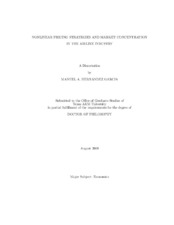| dc.description.abstract | This dissertation investigates the effect of market concentration on nonlinear
pricing strategies in the airline industry. The study develops a theoretical nonlinear
pricing model with both discrete product and consumer types to derive testable implications about the impact of market concentration on the structure of relative prices
within a menu of prices. The analysis then uses a unique, airline ticket level data
set to test the model predictions. The data set consists of a representative sample
of airline tickets purchased between June and December 2004 from one major Computer Reservation System (CRS), for travel in the fourth quarter of the same year.
The study restricts attention to 246 domestic routes in the United States, resulting
in 878,169 tickets. This unique data set allows us to examine the effect of market
structure conditions on relative prices within a menu of fare types with restrictive
ticket characteristics. The analysis also contributes to the understanding of how the
level of competition in a market affects the dispersion of airline prices.
The results indicate that market concentration differentially impacts high versus
low priced fares, as predicted by the theoretical model. More specifically, there is a
decrease in the ratio of high- to low-quality fares as markets become more concentrated, after controlling for numerous factors that may affect prices through costs and
market characteristics. The ratio of medium- to low-quality fares, however, increases
with less competition. From a welfare perspective, it is interesting to observe that not
all travelers are affected in the same way by a decrease in the level of competition. Business travelers, who purchase high priced fares, end up paying relatively lower
prices in more concentrated markets while leisure travelers pay more. | en |


